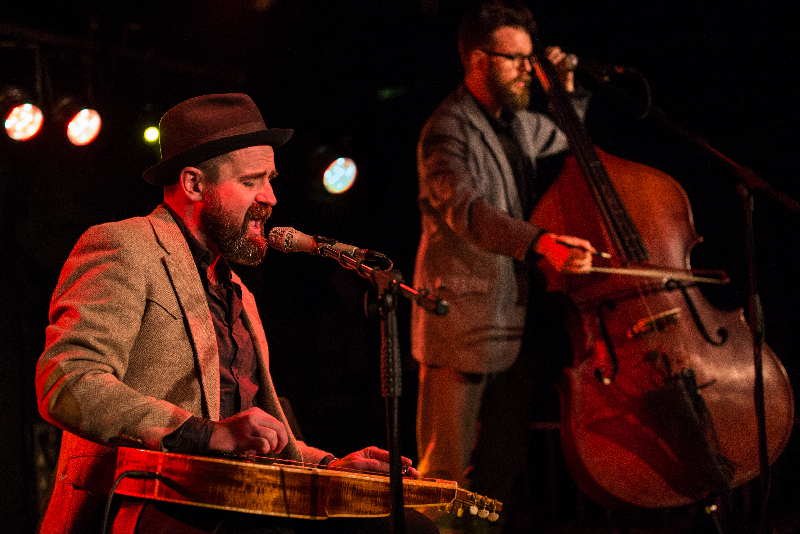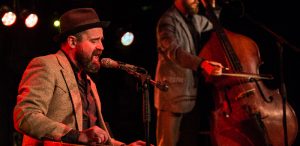
British folk-bluesman Martin Harley had recorded five solo albums prior to meeting bassist Daniel Kimbro. Now he’s on the verge of releasing his second collaborative album with the U.S.-based musician and returns to Band on the Wall with him on 9th March, armed with the new material from their forthcoming release. The pair have a great on-stage rapport, with Kimbro’s bass work allowing for Harley’s slide playing to be more meandering and expressive than it could be playing solo. We began our interview with Harley asking about their first meeting and their comradery.
What was apparent from your show here with Daniel last year was your comradery; how did you meet and what strengthened your musical bond to the point that you toured together?
We met on the back of a U-Haul truck at a festival in Tennessee. The intention was to run a song or two to play on stage but when we got up there we played an hour long set. I found that pretty exciting and nerve racking. It was out of my comfort zone but I think that it helped me to improve and improvise more on stage. That’s why touring has been so much fun over the last couple of years.
You recorded your new studio album with Daniel and several acclaimed musicians, in Nashville. Can you tell us about the recording process and whether the City and it’s history imbued the work you did there?
The players in Nashville are great. You never know who might be hanging around at a loose end, willing to come and play on your record. We recorded live over four days at Wow & Flutter in the East part of town. Most songs are either the first or second take. We tried to keep it simple and honest to avoid crowding the songs.
Where does the title Static in the Wires come from? Is it a recording related phenomenon or more relevant to particular subject matter in the songs?
It’s a line from my song ‘Dancing on the Rocks’. The phrase refers to how messages and feelings travel throughout wires, but also we didn’t use any digital gear to make this record, everything was connected by wires. It’s also how we get to hear the end product, so I guess it has a few meanings for me.
You’ve picked some songs which you’re enjoying at the moment and may have shaped the sound of the record. What can you tell us about those…
JJ Cale – Super blue: A masterpiece of ‘less is more’ songwriting. JJ Cale has such great note choice in his playing. He’s never in a rush and the song just floods over you with beautifully simple peddle steel and a killer dry acoustic guitar solo.
Ryan Adams Live at Carnegie Hall – My Sweet Carolina: In my opinion Ryan Adams is one of the best songwriters around. Consistently believable, beautifully crafted melancholy songs. This striped down version shows how powerful one and man an acoustic guitar can be.
Santo and Johnny – Summertime: This duo from the ’50s really make the most of the lap steel guitar. The delivery on this song is hard to beat. The guitar tones are sublime and this record played a huge part in how I’ve tried to create my own guitar tone on this album.
John Martyn – Bless the weather: John’s voice is a unique instrument. Sometimes it almost sounds saxophone like. The interplay between Danny Thomson on upright bass and John’s acoustic guitar is spellbinding. There’s a clear influence on songs like ‘Dancing On The Rocks’ from ‘Static in the Wires’.
Josh Ritter – Wings: This song almost has a Cormack McCarthy narrative to it. Great lyrics and visual imagery make you feel part of the journey and perhaps even the redemption.
What’s on your mind when you’re sitting down to play or write? Do you need to be in a particular head space before you attempt either, or is the act of playing a cleanser itself?
Usually it’s when the family go out and I have the house to myself. I almost always write things worth keeping in the morning. I love the space between sleep and consciousness. If I manage not to talk to anyone before I get to my guitar that really helps. I’m easily distracted.
Thinking about the history of the blues and the folk music that arrived in America, Alan Lomax is one of the first names that springs to mind for bringing the music to a wider audience and ensuring it survived for future generations. How did you come to find these styles of music and was his work a part of your discovery?
Yes, we owe Lomax a great deal in term of cataloguing American folk music. I also believe he presented some blues artists in a fairly negative way. Early blues recordings have always cast a spell over me. I grew up with the new romantics on Top of the Pops and that really meant nothing to me. On hearing scratchy old blues records as a teenager, I became absorbed with the sounds and imagery of a culture very distant from my own. For a reason I still cant explain, it had a voice I understood and felt affinity with. I’m drawn to the darker and more melancholic music. It just seems more beautiful and honest to me.
What are your plans for 2017 beyond your forthcoming tour?
More touring, more touring and after that more touring. UK, Europe and Canada a couple of times each before the year is done. I’m also hoping people are going to buy my new album so that I can afford to make a another one!


